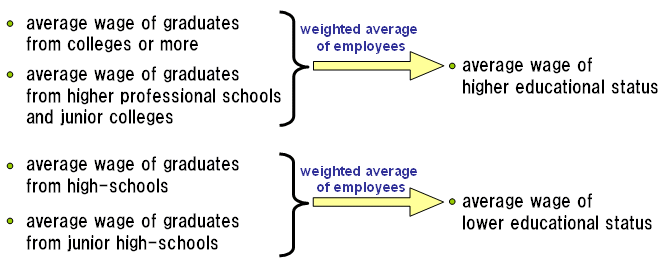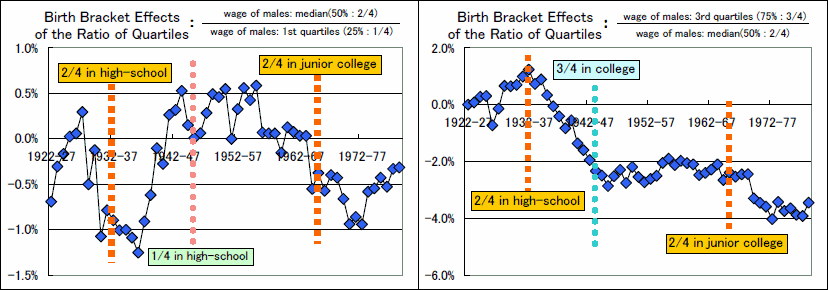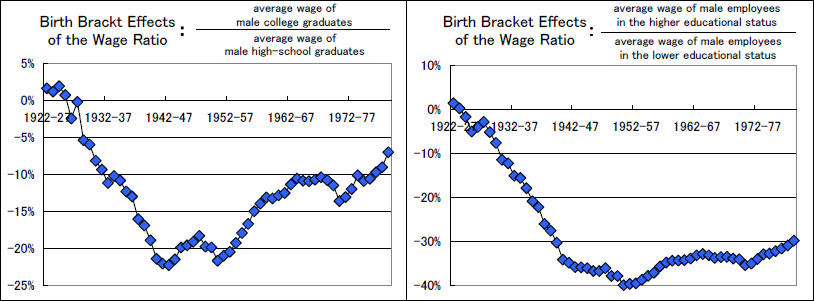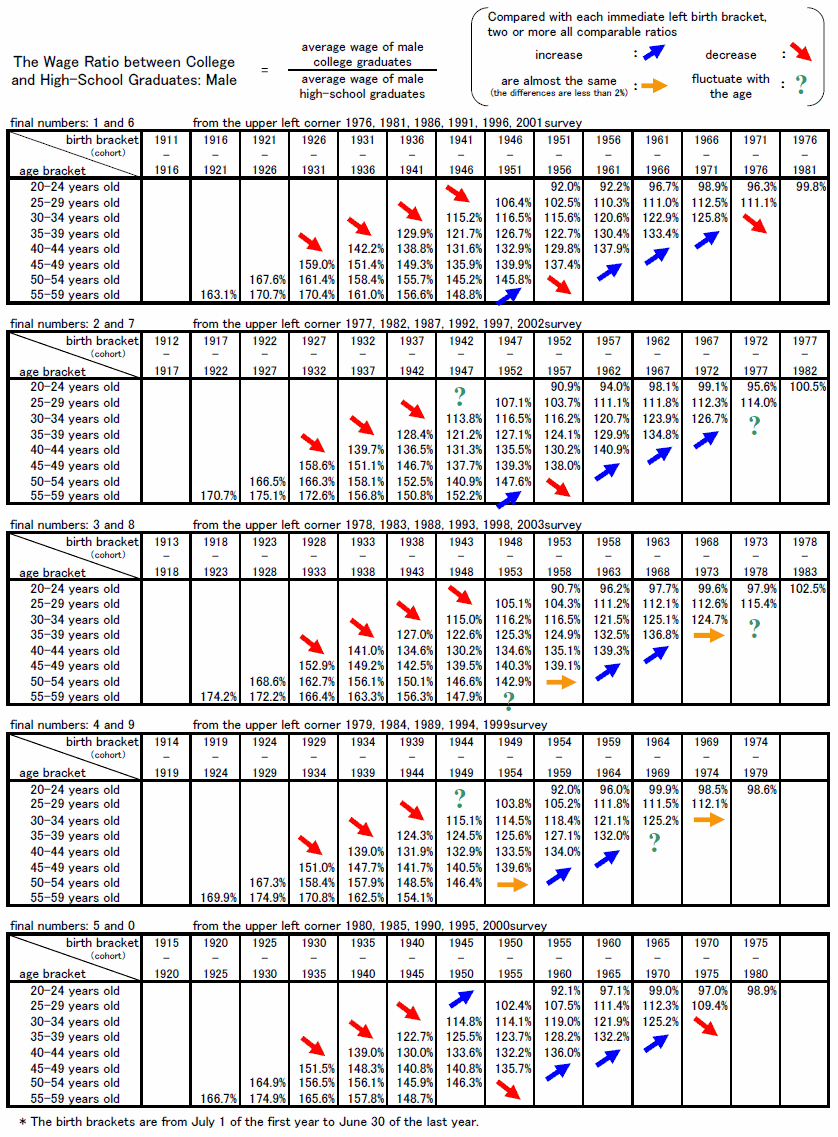[Do Schools Form Human Capital? (2)Wage Differentials in Japan]
This page outlines "Do schools form human capital? Distributional divide and cohort-based analysis in Japan".
I analyze the real effects of higher education on wages in Japan.
This page is continued from Do Schools Form Human Capital? (1)Economics of Education.
(1)Economics of Education and (2)Wage Differentials in Japan are also written in Japanese.
2.1 The Wage Ratio as Wage Differential
3.3 The Wage Ratio on Weighted Averages
3.4 Key Points of Empirical Wage Analyses in Japan
Do schools form human capital? Distributional divide and cohort-based analysis in Japan is full text PDF (700KB) analyzes wage gap of Japan
Learn fallacy of wage differentials with cohort data in 10 minutes is PDF (140KB) of this Web page for print. It's 6-page summary of the above two papers
Simulation of Ratio between Averages is Excel (50 KB) simulation of the ratio between average or wage ratio with an arbitrary distribution and effect of education.
This page is continued from Do Schools Form Human Capital? (1)Economics of Education.
3.1 The Wage Ratio between College and High-school Graduates
This page analyzes the change in the wage ratio with data in Japan. The data has been collected through 28 consecutive annual surveys titled Basic Survey on Wage Structures (BSWS) from 1976 to 2003. The BSWS provides the most comprehensive information on wages in Japan.
- The Ministry of Health, Labour and Welfare of Japan compiles the BSWS. Each survey is based on approximately 1.5 million employees. The BSWS is one of the most reliable and long-running wage data in the world.
- BSWS basically collects data from private firms.
The wage data for analyses are calculated by adding the annual special cash earnings to twelve times the contractual monthly cash earnings in June .It represents annual wage. Even though I use hourly wages instead of the annual wages, the principal results in this paper are robust. The BSWS categorized the levels of education into four classes:
The wage ratio between (2) high-school graduates and (4) college graduates is considered as a primary indicator of the wage differential across educational statuses. At first, I tabulated the wage ratio of male employees as shown in five tables below. Each table lines up from the upper-left line to the lower-right for every 5 surveys. Published BSWS records the average wages of five-year age brackets. I term the column birth bracket in accordance with age bracket of row. These five lined-up tables are based on five-year period birth brackets. Owing to this five-year arrangement, the birth brackets do not overlap in each table. I mark the comparison on the immediate left column on five tables.
The educational advancement rate in Japan as well as in many countries has increased substantially in the 20th century. Schooling in youth virtually decides the share of educational status in each birth bracket. Fixing the birth bracket is almost equivalent to fixing the share of educational status regardless of the age bracket. Therefore, comparing the columns of the birth bracket enables the analysis of the effect of the educational advancement rate on the wage ratio.
- The annual wage is a prime indicator in wage analyses of Japan. Hourly wage is not common because the working time is hard to measure, especially among highly-educated employees. Although I have used hourly wages instead of the annual wages, the principal results given in this page are robust.
- The five tables demonstrate moot points of return from schooling (e.g. lifetime wage, internal rate, and Mincer wage equation). Most analyses including Education at a Glance 2007 calculate the returns based on wage differentials at a specific time point. The calculations are based on the slant line of the above tables. Actual wage differentials are mainly affected by the columns in the tables. The slant lines in the tables do not correspond with any birth brackets. In addition, the main reason for changes by columns is a statistical trick as described later.
There are two irregular movements in transition of birth bracket effects about 1953 and 1973. Despite the irregular movements, on the whole, the birth bracket effects increase after a decline along with the generational progress. This transition seems to match [2] in 2.3 Key Points of Wage Ratio. However, one of the assumption on the example and simulation is not satisfied with the BSWS. The example on 2.2 A Misleading Point of the Wage Ratio and Simulation of Ratio between Averages indicated the relationship between one dividing line and the wage ratio. On the other hand, the wage ratio obtained from the BSWS considers only two educational statuses, namely, college and high-school graduates, and it excludes the other two. Though the wage ratio between (2) high-school graduates and (4) college graduates indicates clear transition, I try to take in the other two educational classes to match the simulation.
- These irregular movements about 1953 and 1973 are mainly from the oil shocks and bubble economy bursts. These indicate that business climates existing at the time of the graduation of students have persistent effects on the wages in Japan. It is consistent with the other wage analyses in Japan.
3.2 The Ratio of Quartiles and Real Effects of Higher Education
Even though I assume a mountain-shaped distribution, there is no general result with three dividing lines. A simple way to create one dividing line is by integrating the weighted average of employees as follows.

However, the weighted average method requires that the effects of education
be negligible. As indicated by [3] in 2.3 Key Points of Wage Ratio, even if education has effects on wages, the transition of the wage ratio
is similar to that in the case of no effect. It is very difficult to measure
the actual effects of education by using only the wage ratios of averages
without specifying the wage distribution. there is a simple method to check
the effects of education without specifying the wage distribution.
Let me present the simmple method with {A, B, C} as on 2.2 A Misleading Point of the Wage Ratio. does not generally balance with
does not generally balance with  regardless of the effect of education. Meanwhile, if education has no
effect on wages, there are some ratios that always balance regardless of
the position of the dividing line. The ratios are simply
regardless of the effect of education. Meanwhile, if education has no
effect on wages, there are some ratios that always balance regardless of
the position of the dividing line. The ratios are simply![]() and
and ![]() . If education has no effect, these ratios always remain constant. Conversely,
let me assume that education has a positive effect and B goes to higher education. In this assumption, the simple result is that
the raised value of the denominator decreases
. If education has no effect, these ratios always remain constant. Conversely,
let me assume that education has a positive effect and B goes to higher education. In this assumption, the simple result is that
the raised value of the denominator decreases ![]() , while the raised value of the numerator increases
, while the raised value of the numerator increases ![]() . The quartiles of wages are useful to check to the effects of education on this idea. The BSWS records quartiles of wage without the separation of educational statuses: the first quartile (25%), the median (50%), and the third quartile (75%).
. The quartiles of wages are useful to check to the effects of education on this idea. The BSWS records quartiles of wage without the separation of educational statuses: the first quartile (25%), the median (50%), and the third quartile (75%).
The ratios of quartiles are calculated by dividing the wage of higher quartile by that of the lower quartile. I decompose the ratio of quartiles into effects of the age and birth brackets. The left lower graph indicates the birth bracket effects of male employees between the first quartile (25%) and the median (50%). The right lower graph indicates the birth bracket effects of male employees between the median (50%) and the third quartile (75%). The upper side of the graphs represents the widening of the gap. I draw dotted lines at the points where the share of educational statuses intersect 25%, 50%, and 75% in the graphs.. For example, 2/4 in high-school means median (50%) male employee is a junior high school graduate at the left (before) side of the dotted line and is a high-school graduate at the right (after) side of the dotted line.
- If the (upper) numerator quartile gets into the next educational status, a label is attached at the head of the dotted line. If the (lower) denominator quartile gets into the next educational status, a label is attached at the bottom of the dotted line

On the whole, the ratios of quartiles decrease when the educational status of the higher quartile changes and increase when the educational status of the lower quartile changes. Most of the people who do not go to higher education get jobs earlier than the ones going to it. Productivities and wages are raised if skills are acquired at work. If the effects of education and that of job are the same, the ratios of quartiles are independent of the share of educational status. However, the graphs imply that the effects of education are generally less than those of job. In other words, higher education has net negative effects on productivities which are reflected in wages.
- The ratios of quartiles change just before the dotted lines pass over the quartiles. This would be consistent if the effects of education are net negative.
Though these graphs imply net negative effects of education, there may be variations that are irrelevant to the effects of education, such as the trend of the decreasing wage gap after the birth bracket of the 1960's. In addition, vertical axes indicate that the total variations are of a few percentage points. If the net effects of education are close to zero, the weighted average method is justified as an acceptable approximation.
3.3 The Wage Ratio on Weighted Averages
The average wage of the employees belonging to lower educational status is calculated from the weighted average of (1) graduates from junior high-schools and (2) graduates from high-schools. In the same manner, the average wage of the employees belonging to higher educational status is calculated from the weighted average of (3) graduates from higher professional schools and junior colleges and (4) graduates from colleges or more. The lower left graph shows the transition of the birth bracket effects between college and high-school graduates based on the data of Five tables in 3.2 The Wage Ratio between College and High-school Graduates in . The lower right graph shows the transition of the birth bracket effects between the higher educational status and the lower one, achieved by using the weighted average.

The transition of the right graph is smoother than the one on the upper left. The spreading time of graduation alleviates the initial effect of new graduates. In addition, taking account of the entire distribution stabilizes the transition based on mountain-shaped distribution.
- Net negative effects of education and the smooth transition of the weighted wage ratio are similar between male employees and female ones.
Only the birth bracket effects of columns and the age bracket effects of rows can account for more than 99% of the wage ratio variations. It is unlikely that there are substantial variations in the wage structures at some point. The main reason for changes in wage differentials in Japan is a statistical trick that results from the distributional divide.
- Five tables in 3.2 The Wage Ratio between College and High-school Graduates also show this point. If there was indeed a skill-biased technological progress in Japan, its influence would emerge on the slanting line in the tables. If slanting lines have significant impact on the wage ratio, the transition of birth bracket effects would be obscure.
3.4 Key Points of Empirical wage analyses in Japan
Here are the key points of wage analyses in Japan.
4. Concluding Remarks
1. Economic Theories about Education introduces the question of whether the human capital theory or the signaling theory is more practical. As indicated by [3] in 3.4 Key Points of Empirical wage analyses in Japan, the results imply net human capital losses, it is safe to state that the signaling theory is more practical at least in the case of Japan. In general, higher education is not suitable for nurturing of employees.
Even if the signaling theory is practical, going to higher education would be profitable from the viewpoint of households. In order to demonstrate his/her productivity, an individual must go to higher education even if productivity decreases. For example, in order to differentiate oneself from another whose capability is 1, a person with a capability of 2 might go to higher education even if his/her capability decreases to 1.9. Though going to higher education is profitable from the view point of households, society suffers from losses in job skill acquisition and economic growth.
Education and learning are virtues in most countries. Schooling possess diverse aspects of culture. However, we have to rethink and discuss about education and schooling.
